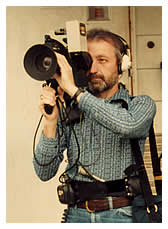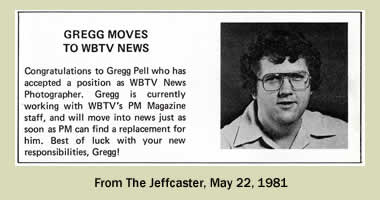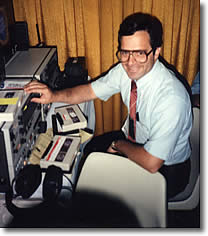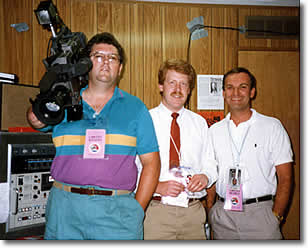
Chuck Hemrick spent years filming straight news stories, then for a long tim was Carolina Camera's cinematographer. Later he was enlisted for the ENG team.


Chuck Hemrick spent years filming straight news stories, then for a long tim was Carolina Camera's cinematographer. Later he was enlisted for the ENG team.
|
||||||||||||||||
First ENG crews -1976
Back row (l to r): Ken Koontz, reporter; Chuck Hemrick, videographer; Brad Stafford, videographer; and Bob Taylor, reporter. Kneeling (l to r) Bobby Lawing, ENG technician-truck operator; Gregg Pell, ENG technician, truck operator. This picture was taken by Tom Landen in front of the station as part of a newspaper promotion. |
Some ENG History
by Gregg Pell
In the summer of 1975, WBTV began the move from film based news photography to electronic videography, and live telecasts from news events. Two things accelerated this move from film to video and live.
First were the dramatic pictures broadcast live in the summer of 1974 of a police shootout in Los Angeles involving the Symbionese Liberation Army. The police had surrounded a house in a residential neighborhood where they thought the SBA was holding Patty Hearst captive. Hearst had been kidnapped several months earlier and was being held for ransom.
 When police closed in, the SBA either set fire to the house or a teargas canister thrown in ignited it. KCBS fed pictures to other CBS affiliates nationwide using a "mini cam" coupled with microwave truck technology. The pictures of the house in flames and police in action were riveting. The CBS network was so impressed that it decided to experiment with the new technology, and took it's affiliate in St. Louis (KMOX) totally electronic (no more film) to work out the bugs before the network as a whole went electronic. WBTV would not be far behind.
When police closed in, the SBA either set fire to the house or a teargas canister thrown in ignited it. KCBS fed pictures to other CBS affiliates nationwide using a "mini cam" coupled with microwave truck technology. The pictures of the house in flames and police in action were riveting. The CBS network was so impressed that it decided to experiment with the new technology, and took it's affiliate in St. Louis (KMOX) totally electronic (no more film) to work out the bugs before the network as a whole went electronic. WBTV would not be far behind.
 |
| Mike Cozza, veteran WBTV political reporter and WBTV Washington Bureau Chief, editing videotape at the Republican National Convention in Dallas Texas in August 1984. WBTV covered both republican and democratic conventions every four years beginning in 1968 and continuing for a number of years. |
Another thing that pushed WBTV to go electronic was the deadly crash of an Eastern Airlines jetliner, killing 63 people near Carowinds in late summer 1974.
WBTV did an award winning job covering the story with film, but a lot of "what ifs" were heard around the station about how ENG technology would have gotten the pictures and story to the audience earlier. WSOC had also decided to investigate the new technology. As I recall (and there may some who have a better memory than I), an aging Ford Econoline van, previously used by Carolina Camera, was crudely outfitted in the summer of 1975 to allow a quick set up of a microwave signal from a news event back to the station for broadcast. An engineer, with the truck at the event, had to coordinate by two-way, lining up the signal with someone at the receiver point downtown on top of the Jefferson-First Union Building in downtown Charlotte. From that building the signal was fed back to the station. Although it was primitive, it worked. And under Jim Babb's leadership a much better system was soon to be on the way. After an infusion of capital from Greensboro in late 1975, work began on a new microwave van, based on simplicity of function. A new relay system was installed on the newly completed 40 story NCNB building in downtown Charlotte that allowed a much quicker set up of signals when an event was to be televised.
 |
| At the 1988 Republican National Convention in New Orleans. Gregg Pell, videographer, Graham Wilson, reporter, and Tom Matesky, CBS White House Producer. Matesky had been a reporter and news manager at WBTV in the early 80s before leaving for CBS in 1985. |
WBTV was one of less than a dozen stations in the country actively using this new technology and was considered a model for others to follow, leading many news directors from other stations to see what we were doing in Charlotte.
The new "live" element added excitement to the newscasts and provided some thrilling moments. The ENG crew of Ken Koontz, Bobby Lawing and Chuck Hemrick pioneered new ground on January 14, 1976, when they fed videotape from the Blue Ridge Parkway back to Charlotte during the 6 o'clock newscast. The video was of a huge fire at a Broyhill furniture plant in Marion that they had shot late in the afternoon. Realizing there was no way to drive the video back to Charlotte by 6pm, they took a chance that by driving up to the nearby parkway they might attain the height needed to get a good microwave signal back to Charlotte.
 |
| Satellite Truck Operator Terry Phillips feeds videotape from "Newstar 3," the station's first satellite news gathering truck, acquired in late 1984. |
A few weeks later, reporter Andrew Schorr and photographer Chuck Hemrick broadcast live from the summit of Mount Mitchell. That same evening, as Schorr and Hemrick were preparing their broadcast from Mount Mitchell, there was breaking news from Independence High School where a ditch had caved in on a utility worker. The second ENG van was dispatched to the scene with Brad Stafford and Gregg Pell, and at the top of the 6 o'clock newscast, back to back live shots were done for the first time in the Carolinas, and probably the southeast The anchors threw to the ditch cave-in first for live pictures, and then to Schorr live on Mount Mitchell.